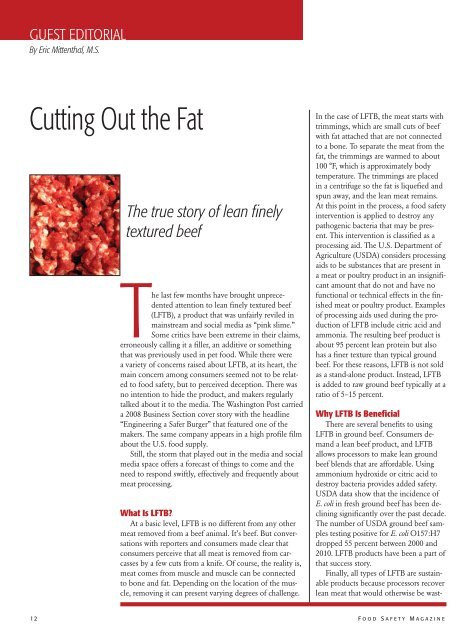Food Safety Magazine, June/July 2012
Food Safety Magazine, June/July 2012
Food Safety Magazine, June/July 2012
You also want an ePaper? Increase the reach of your titles
YUMPU automatically turns print PDFs into web optimized ePapers that Google loves.
GUEST EDITORIAL<br />
By Eric Mittenthal, M.S.<br />
Cutting Out the Fat<br />
The true story of lean finely<br />
textured beef<br />
The last few months have brought unprecedented<br />
attention to lean finely textured beef<br />
(LFTB), a product that was unfairly reviled in<br />
mainstream and social media as “pink slime.”<br />
Some critics have been extreme in their claims,<br />
erroneously calling it a filler, an additive or something<br />
that was previously used in pet food. While there were<br />
a variety of concerns raised about LFTB, at its heart, the<br />
main concern among consumers seemed not to be related<br />
to food safety, but to perceived deception. There was<br />
no intention to hide the product, and makers regularly<br />
talked about it to the media. The Washington Post carried<br />
a 2008 Business Section cover story with the headline<br />
“Engineering a Safer Burger” that featured one of the<br />
makers. The same company appears in a high profile film<br />
about the U.S. food supply.<br />
Still, the storm that played out in the media and social<br />
media space offers a forecast of things to come and the<br />
need to respond swiftly, effectively and frequently about<br />
meat processing.<br />
What Is LFTB?<br />
At a basic level, LFTB is no different from any other<br />
meat removed from a beef animal. It’s beef. But conversations<br />
with reporters and consumers made clear that<br />
consumers perceive that all meat is removed from carcasses<br />
by a few cuts from a knife. Of course, the reality is,<br />
meat comes from muscle and muscle can be connected<br />
to bone and fat. Depending on the location of the muscle,<br />
removing it can present varying degrees of challenge.<br />
In the case of LFTB, the meat starts with<br />
trimmings, which are small cuts of beef<br />
with fat attached that are not connected<br />
to a bone. To separate the meat from the<br />
fat, the trimmings are warmed to about<br />
100 °F, which is approximately body<br />
temperature. The trimmings are placed<br />
in a centrifuge so the fat is liquefied and<br />
spun away, and the lean meat remains.<br />
At this point in the process, a food safety<br />
intervention is applied to destroy any<br />
pathogenic bacteria that may be present.<br />
This intervention is classified as a<br />
processing aid. The U.S. Department of<br />
Agriculture (USDA) considers processing<br />
aids to be substances that are present in<br />
a meat or poultry product in an insignificant<br />
amount that do not and have no<br />
functional or technical effects in the finished<br />
meat or poultry product. Examples<br />
of processing aids used during the production<br />
of LFTB include citric acid and<br />
ammonia. The resulting beef product is<br />
about 95 percent lean protein but also<br />
has a finer texture than typical ground<br />
beef. For these reasons, LFTB is not sold<br />
as a stand-alone product. Instead, LFTB<br />
is added to raw ground beef typically at a<br />
ratio of 5–15 percent.<br />
Why LFTB Is Beneficial<br />
There are several benefits to using<br />
LFTB in ground beef. Consumers demand<br />
a lean beef product, and LFTB<br />
allows processors to make lean ground<br />
beef blends that are affordable. Using<br />
ammonium hydroxide or citric acid to<br />
destroy bacteria provides added safety.<br />
USDA data show that the incidence of<br />
E. coli in fresh ground beef has been declining<br />
significantly over the past decade.<br />
The number of USDA ground beef samples<br />
testing positive for E. coli O157:H7<br />
dropped 55 percent between 2000 and<br />
2010. LFTB products have been a part of<br />
that success story.<br />
Finally, all types of LFTB are sustainable<br />
products because processors recover<br />
lean meat that would otherwise be wast-<br />
12 F o o d S a f e t y M a g a z i n e






![Otomatik indirilmez ise tıklayınız [Download]](https://img.yumpu.com/44170525/1/190x190/otomatik-indirilmez-ise-taklayanaz-download.jpg?quality=85)










